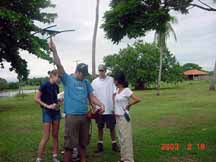Training
Lyssa
We awoke at 6:15 to a breakfast of bread, cheese, and fruit. An hour later we were off to the classroom to begin our orientation. Helen, the scientist studying river otters, explained about river otters, how we would help with her research, and why it was all important.
Helen briefly went over how otters use their dens, their behavior when they eat, and their behaviors when they hunt for their food. The age of otters can be determined by how they eat their fish (head or tail first), and individuals can be distinguished from each other by the markings on their chest. Also, they eat at different rates depending on how long they have been consuming fish... in the beginning they eat quickly and often; as they fill up they slow down and catch their fish less often.
Our job is to make observations about the behavior and habitat of the otters; this includes collecting and washing scat to see what they eat by comparing the bones in the scat (dung) with a database of fish bones in the lab. She stressed that spotting otters during the wet season would be very hard and that even though we might not see an otter in an area we would still have to record data.
Ellen, who is monitoring all the projects on the Fazenda, explained to us some of the things that she does and what we would be doing in the field. Tracking radio-collared peccaries is one of the ongoing things she does and something that we would be doing on a day-to-day basis. Ellen has an antenna and a frequency detector that she uses to see if any of the peccaries are in or around an area that she is in. When stopped in an area she revolves the antenna around her while tuning the frequency to try and find an animal. If she detects a frequency , she then triangulates to try and locate an area where the animal is.
 |
 |
 |

Nick, Lyssa, and Andrew practice locating a mammal (Phil) who is wearing a radio collar. |
 |
 |
 |
Ellen quickly drew out an example on a piece of paper of how triangulation exactly works, and then she had us try it out. We used Phil as a test peccary so he was given a radio collar and then he went and hid. When we thought we had given him enough time to hide, we went outside of the classroom and tried to locate Phil. Nick used the antenna and the frequency box to try and get a signal (which was difficult since we kept getting signals from all around). We then record the bearing off the compass. We all then walked 90 meters in the direction of the signal and tried to relocate the signal with the antenna; we re-found the bearing and recorded it. That was it; we had made our circle and found the area in which Phil probably was. We were all slightly disappointed since we thought we would be finding Phil more along the lines of hide-and-go-seek, but it was much more technical. We had some idea of where he was, and we found Phil's hiding place behind the kitchen pretty quickly.
For more information, click on the Hudson School site.

